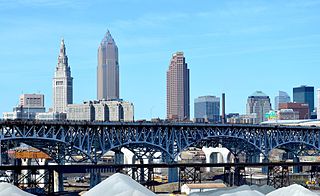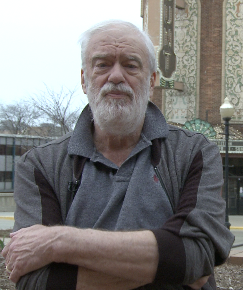
The Cleveland metropolitan area, or Greater Cleveland as it is more commonly known, is the metropolitan area surrounding the city of Cleveland in Northeast Ohio, United States. According to 2017 United States Census estimates, the five-county Cleveland–Elyria Metropolitan Statistical Area (MSA) consists of Cuyahoga County, Geauga County, Lake County, Lorain County, and Medina County, and has a population of 2,058,844, making Greater Cleveland the 33rd most populous metropolitan area in the United States, the third largest metro area in Ohio, and the second largest metro area, behind Columbus, entirely in Ohio. Greater Cleveland is part of the larger Cleveland–Akron–Canton Combined Statistical Area and the Great Lakes Megalopolis.

Euclid Avenue is a major street in Cleveland, Ohio. It runs northeasterly from Public Square in Downtown Cleveland, through the cities of East Cleveland, Euclid and Wickliffe, to the suburb of Willoughby as a part of U.S. Route 20 and U.S. Route 6. The street passes Playhouse Square, University Circle, Cleveland State University, the Cleveland Clinic, Severance Hall, Case Western Reserve University’s Maltz Performing Arts Center, Case Western Reserve University and University Hospitals Case Medical Center. The HealthLine bus rapid transit line runs in designated bus lanes in the median of Euclid Avenue from Public Square to Louis Stokes Station at Windermere in East Cleveland.

Great Lakes Theater, originally known as Great Lakes Shakespeare Festival, is a professional classic theater company in Cleveland, Ohio, USA. Founded in 1962, Great Lakes is the second-largest regional theater in Northeast Ohio. It specializes in large-cast classic plays with a strong foundation in the works of Shakespeare and features an educational outreach program. The company performs its main stage productions in rotating repertory at its state-of-the-art new home at the Hanna Theatre, Playhouse Square, which reopened on September 20, 2008. The organization shares a resident company of artists with the Idaho Shakespeare Festival. On its main stage and through its education programs, GLT connects approximately 85,000 adults and students to the classics each season.

Thomas White Lamb (1871–1942) was an American architect, born in Scotland. He is noted as one of the foremost designers of theaters and cinemas in the 20th century.
Cleveland Play House (CPH) is a professional regional theater company located in Cleveland, Ohio. It was founded in 1915 and built its own noted theater complex in 1927. Currently the company performs at the Allen Theatre in Playhouse Square where it has been based since 2011.

The Connor Palace is a theater located at 1615 Euclid Avenue in Downtown Cleveland, Ohio, part of Playhouse Square. The theater opened in 1922, as Keith's Palace Theatre after B. F. Keith, founder of the Keith-Albee chain of vaudeville and movie theaters. It was designed by the Chicago architectural firm of Rapp and Rapp in the French Renaissance style, and originally housed live two-a-day vaudeville shows. The $2 million theater opened in the Keith Building on November 6, 1922, seating 3,100. The interior featured Carrara marble and 154 crystal chandeliers, and the main lobby, dubbed the "Great Hall," was decorated with over 30 paintings.

The Ohio Theatre is a theater on Euclid Avenue in downtown Cleveland, Ohio, part of Playhouse Square. The theater was built by Marcus Loew's Loew's Ohio Theatres company. It was designed by Thomas W. Lamb in the Italian Renaissance style, and was intended to present legitimate plays. The theater opened on February 14, 1921, with 1,338 seats. The foyer featured three murals depicting the story of Venus, and the balcony contained paintings of Arcadia. Throughout the 1920s, the Ohio had a stock company and hosted traveling Broadway plays.
Ohio Theatre or Ohio Theater may refer to:

The KeyBank State Theatre is a theater located at 1519 Euclid Avenue in downtown Cleveland, Ohio. It is one of the theaters that make up Playhouse Square. It was designed by the noted theater architect Thomas W. Lamb and was built in 1921 by Marcus Loew to be the flagship of the Ohio branch of the Loew's Theatres company.

The Keith Building is a skyscraper in downtown Cleveland, Ohio's Playhouse Square theater district. The Keith is 272 feet tall and 21 stories, and houses the Palace Theater, a former flagship theater of the Keith vaudeville circuit. As of 2017, the renovated building is in use as an office tower.
The Allen Theatre is one of the theaters in Playhouse Square, the performing arts center on Euclid Avenue in downtown Cleveland, Ohio. It was originally designed as a silent movie theater by C. Howard Crane and opened its doors on April 1, 1921 with a capacity of more than 3,000 seats. The first show was of the movie Her Greatest Love, and featured Phil Spitalny and his 35 piece orchestra as live performers. The theater was designed in the Italian Renaissance style and was one of the few "daylight atmospheric" theaters in the country, with a ceiling painted to resemble the open daylight sky. In the lobby, a rotunda was built to resemble the Villa Madama in Rome. The ceiling of the rotunda was decorated with Renaissance-style figures from an unknown artist's imagination which greeted cinema patrons for decades.

The Hanna Theatre is a theater at Playhouse Square in downtown Cleveland, Ohio, United States. It is one of the original five venues built in the district, opening on March 28, 1921. The Hanna Theatre reopened in 2008 as the new home of Great Lakes Theater Festival after a major renovation by the classic theater company.
For the theater that was once in New York City see Fourteenth Street Theatre

Kennedy's Theatre is a theater in downtown Cleveland, Ohio, part of the Playhouse Square. It is located in the basement under the Center. It is mostly used for intimate performances as it can only fit about 50 comfortably. The space can be repurposed depending on the production.

Detroit–Shoreway is a neighborhood on the West Side of Cleveland, in the U.S. state of Ohio. Detroit–Shoreway consists of the streets between Lake Erie and Interstate 90, from West 85th to West 45th streets.

Ray Shepardson was a theatre restoration specialist and theatre operator credited by many with beginning the trend toward restoring old unused movie theaters into economic engines for their communities. He is the founder of the Playhouse Square association in Cleveland and is recognized as the visionary that helped motivate the creation of one of the nation's largest performing arts districts. He was involved in 40 restorations throughout his career and operated several theaters after their restoration.

The Hanna Building is a historically renovated high-rise in downtown Cleveland's Theater District on the corner of East 14th Street and Euclid Avenue. The building stands 194 feet high and rises to 16 stories. It was built in 1921 and was added to the National Register of Historic Places in 1978. The Hanna is part of the Playhouse Square historic property portfolio and features many of the same features such as news tickers, billboards, and decorative elements as the other "theatrical" buildings in the locale. The Hanna is highly recognizable on the Playhouse Square and is currently the third tallest building in the Theater District behind the B.F. Keith and the US Bank Centre. Like many buildings of the era, the Hanna sits in an oblong fashion in relation to the street grid and runs parallel to the roadways of Euclid Avenue and East 14th Street, respectfully.














